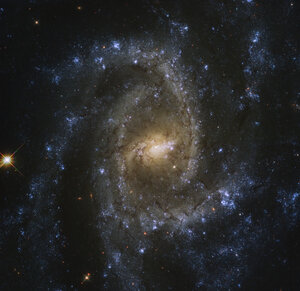

On the hunt for newborn stars
This image, taken with the NASA/ESA Hubble Space Telescope’s Wide Field Camera 3 (WFC3), shows a patch of space filled with galaxies of all shapes, colours, and sizes. WFC3 is able to view many such galaxies at an unprecedented resolution — high enough to locate and study regions of star formation in a bid to understand how new stars spring to life throughout the cosmos.
Stars are born within giant clouds of gas. These massive clouds, or stellar nurseries, grow unstable and begin to collapse under gravity, becoming the seeds that will grow into new stars. By analysing the luminosity, size, and formation rate of different stellar nurseries, scientists hope to learn more about the processes that can lead to the formation of a newborn star. Studying nurseries within different galaxies will provide information about star formation at different points in time and space throughout the Universe.
Just below centre in this image is a formation of galaxies akin to a smiling face! Two yellow-hued blobs hang atop a sweeping arc of light, forming a celestial object known as SDSSJ0952+3434. The lower, arc-shaped galaxy has the characteristic shape of a galaxy that has been gravitationally lensed — its light has passed near to a massive object en route to us, causing it to become distorted and stretched out of shape.





